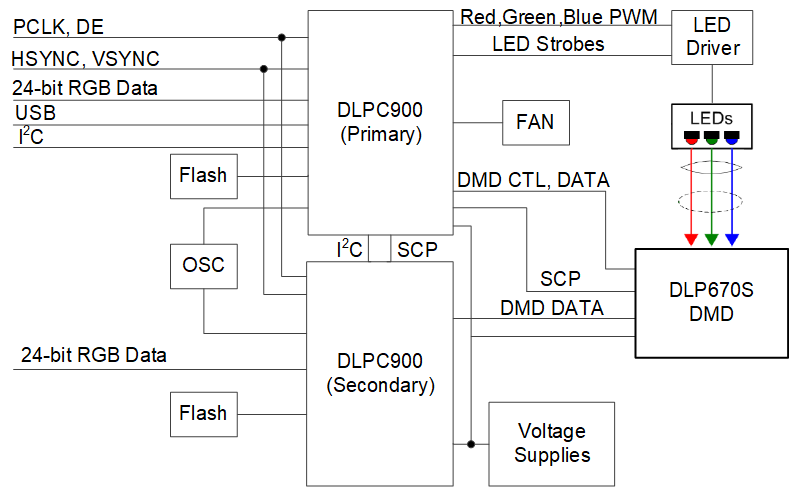ZHCSKV8A November 2020 – June 2022 DLP670S
PRODUCTION DATA
- 1 特性
- 2 应用
- 3 说明
- 4 Revision History
- 5 Pin Configuration and Functions
-
6 Specifications
- 6.1 Absolute Maximum Ratings
- 6.2 Storage Conditions
- 6.3 ESD Ratings
- 6.4 Recommended Operating Conditions
- 6.5 Thermal Information
- 6.6 Electrical Characteristics
- 6.7 Capacitance at Recommended Operating Conditions
- 6.8 Timing Requirements
- 6.9 Typical Characteristics
- 6.10 System Mounting Interface Loads
- 6.11 Micromirror Array Physical Characteristics
- 6.12 Micromirror Array Optical Characteristics
- 6.13 Window Characteristics
- 6.14 Chipset Component Usage Specification
- 7 Detailed Description
- 8 Application and Implementation
- 9 Power Supply Recommendations
- 10Layout
- 11Device and Documentation Support
- 12Mechanical, Packaging, and Orderable Information
3 说明
拥有超过 430 万个微镜的 DLP670S 数字微镜器件 (DMD) 是一种空间光调制器 (SLM),调制入射光的振幅、方向和相位。此 DMD 与四条 2xLVDS 输入数据总线相结合,能够以极快的图形速率显示高分辨率图形。DLP670S 提供的高分辨率和快速图形速率使其非常适合支持各种工业、医疗和高级成像应用。DLP670S 与双 DLPC900数字控制器配合使用时可实现可靠功能和操作。此专用芯片组以满足各种终端设备解决方案要求所需的高图形速率提供灵活且易于编程的图形。
高分辨率支持扫描更大的物体,这对于 3D 机器视觉应用有直接帮助。
进入 TI DLP® 高级光控制技术页面,了解如何开始使用 DLP670S。TI.com 上的 DLP 先进光控制资源可加快上市速度,这些资源包括评估模块、参考设计、光学模块制造商和 DLP 设计网络合作伙伴。
表 3-1 器件信息
| 器件型号 | 封装 | 封装尺寸(标称值) |
|---|---|---|
| DLP670S(1) | FYR (350) | 35mm × 32mm |
(1) 如需了解所有可用封装,请参阅数据表末尾的可订购产品附录。
 DLP670S 简化原理图
DLP670S 简化原理图